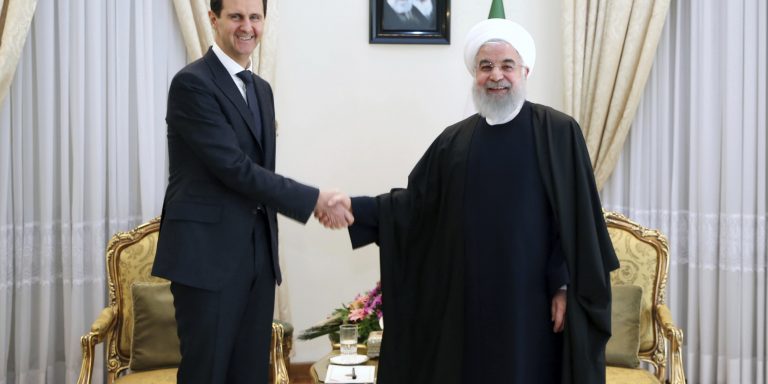INTELBRIEF
March 4, 2020
IntelBrief: Iran’s Strategy in Syria

- Iran’s intervention in Syria’s civil war has provided Tehran with the ability to support its closest regional allies while simultaneously threatening Israel.
- Iran’s success in buttressing the Assad regime exemplifies the effectiveness of its regional strategy.
- Iran’s support for Assad threatens to bring Iranian forces into direct conflict with Turkish troops and Turkish-backed Syrian rebels in northern Syria.
- Iran is unlikely to undertake action in Syria that would bring it into direct conflict with the United States.
.
It is readily apparent why the preservation of the regime of President Bashar Al Assad of Syria is pivotal to Iran’s regional strategy. Syria borders Lebanon, where Iran’s closest regional ally, Lebanese Hezbollah is based. Syria also shares a border with Israel, which is Iran’s most powerful regional adversary. When Assad’s regime was under severe pressure from a major armed rebellion in 2013, Iranian leaders felt compelled to intervene with all elements of national power to prevent his regime from falling. Iranian leaders were alarmed that Assad's potential downfall, particularly to a regime headed by Sunni Muslims, would eliminate a key supply line through which Iran provides arms to Hezbollah. Conversely, deploying Iranian power to assist Assad could, as an added benefit, position Iran not only to secure a strategic land bridge through which to supply Hezbollah, but also to apply increased pressure on Israel.
When Assad appeared close to defeat, Iran implemented its classic ‘playbook’ for wielding regional power – advising its local allies and recruiting and building up Shia militia forces as proxies through which Iran can project power. The ‘playbook’ included sending to Syria not only 2,500 advisers from the Islamic Revolutionary Guard Corps – Qods Force (IRGC-QF), but also units of Iran’s regular army as well. Additionally, Iran facilitated the deployment to Syria of about 8,000 Hezbollah fighters from Lebanon to fight alongside Syrian military units. Iran’s innovation in Syria was to also recruit and deploy about 25,000 Shia fighters from Afghanistan and Pakistan to form the Fatimiyoun and Zaynabiyoun brigade, respectively. When coupled with Russian air support, by 2016, this Iranian support had largely secured Assad’s regime, preserved Iran’s equities in Syria, and confirmed the effectiveness of Iran’s ‘playbook’ in implementing Tehran’s regional strategy.
At the same time, opposition control of territory in Idlib province and other parts of northern Syria reminds Iran that its main mission in Syria is not over. IRGC and Iran-backed forces, including Hezbollah and the Afghan and Pakistani Shia forces, have been fighting alongside the Syrian military for several months to try to recapture the remaining territory in the north that Assad does not hold. Yet, that campaign has brought Syrian and Iran-backed forces into combat in early 2020 with Turkish forces that are in Idlib under an earlier Russia-backed ceasefire agreement for the province. Some Iranian forces and their allies have been killed in the fighting, prompting Iran’s command headquarters in Syria to warn Turkey that some of its population is within range of Iranian force. Still, it is likely that Iran will engage in negotiations to ensure that it does not get drawn further into a war with Turkey, which is a member of NATO. With remaining fighting limited largely to Idlib, Iran has sought to entrench its presence in Syria to accomplish broader objectives. Iran reportedly has built military production factories in Syria that supply Hezbollah with ever more precise short-range ballistic missiles and rockets that are aimed at Israel. Israel has recognized this growing threat and regularly strikes Iranian targets in Syria to prevent Iran from developing a broad, secure military production infrastructure in Syria. So far, only minor Iran-Israel clashes have taken place as a consequence of the Israeli bombing campaign, and both countries appear to want to avoid escalation.
Another consequence of Iran’s intervention in Syria has been to provide Iran with the opportunity to secure a land corridor from Iranian territory all the way to Lebanon, and thereby reduce its reliance on flights to Damascus or Beirut to supply Hezbollah with advanced weaponry. However, one objective of the U.S. deployment of a small force to eastern Syria, particularly the small garrison at Al Tanf, has been to thwart Iran from establishing that supply line. To date, U.S. military decision-makers have cited that objective in convincing President Trump to insulate that garrison from reductions in the overall U.S. footprint in Syria. Iran apparently has sought to pressure that U.S.-manned outpost by sending Iran-backed militias toward a declared security zone surrounding Al Tanf, including as recently as mid-February 2020. U.S. forces have driven the advancers off each time. The Iranian challenges to Al Tanf come in the context of broad U.S.-Iran tensions and recent hostilities between the two countries in Iraq, including the January 3, 2020 U.S. killing of IRGC-QF commander Qasem Soleimani and Iran’s retaliatory missile strike on Ayn Al Asad base in Iraq, on January 8. Iran is likely to continue to probe U.S forces in Syria to try to secure its land corridor to Lebanon, but unlikely to escalate in Syria to the point of widening conflict with the United States.
.
For tailored research and analysis, please contact: info@thesoufancenter.org